Chinon to Fontevraud-l’Abbaye
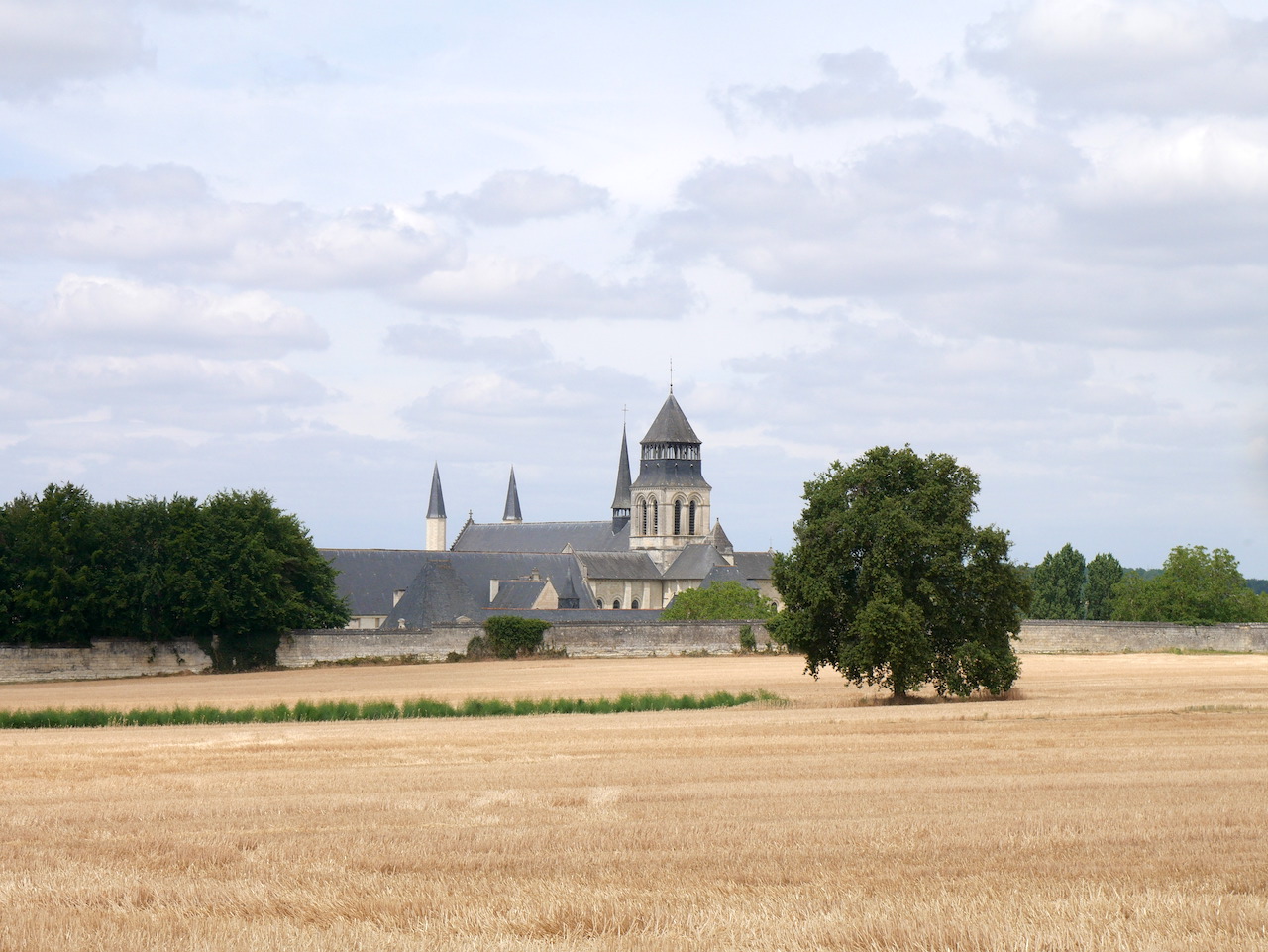
Centre-Val de Loire
11. Chinon to Fontevraud-l’Abbaye
Easy
4h30
17,6km
+202m
-166m
Step
Embed this item to access it offline
Leaving Chinon you cross the Vienne River, it accompanies you for 10 kilometers, time to admire the royal fortress on the right bank. At La Chaussée, you climb on a plateau with its cereal crops to enter the forest of Fontevraud. The Royal Abbey of Fontevraud is in sight with its history and its preserved monastic complex.
8 points of interest
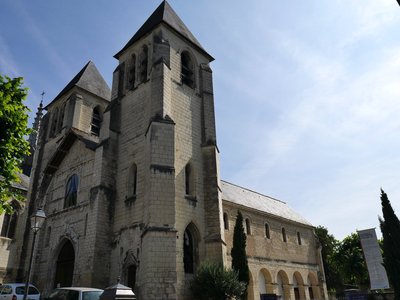
Collégiale Saint-Mexme - Amis saint Colomban TouristSaint-Mexme Collegiate Church in Chinon
Gregory of Tours, in his "De la gloire des confesseurs" (On the glory of the confessors), recounts the installation in the 5th century of Mexme, a disciple of Saint Martin, in a troglodytic hermitage in Chinon, to the east of the Roman castrum which was to become the present castle. Saint Mexme is said to have founded a first church, which served as the centre of a small monastery, transformed into a collegiate church around the year 1000. The church was then rebuilt on a basilical plan, then enlarged in 1050 by the addition of a western massif comprising a narthex framed by two towers. In the 12th century, the nave was extended towards the west, a transept and a choir with an ambulatory and radiating chapels completed the transformation of the collegiate church into a vast pilgrimage building.
After the Revolution, work was necessary to return the building to worship, but in 1817, the collapse of the bell tower at the transept crossing led to the ruin of the eastern parts. The remaining parts, the nave and the western section, were then transformed into a school until 1980. A vast restoration work was then undertaken, accompanied by excavations to learn more about the history of the building. The collegiate church is today an open cultural centre for temporary exhibitions. The Collegiate Church contains mural paintings from the 12th to the 15th centuries.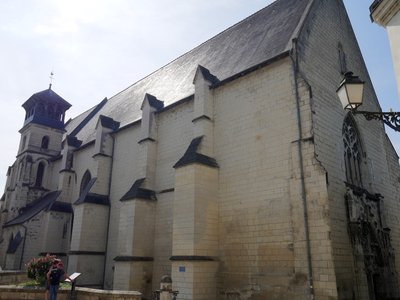
L’église Saint-Étienne de Chinon - Amis saint Colomban TouristSaint-Étienne Church of Chinon
This church was rebuilt between 1460 and 1490 by the architect Pierre Mesnager for Philippe de Commines. It occupies the place of a Romanesque building of which the base of the bell tower is a vestige (11th century). The facade is pierced by a double basket-handle door, surmounted by two hooks and fleurons braces, inscribed on either side of a canopy niche, in a tympanum circumscribed by a large brace falling on two buttresses hollowed out of niches and decorated with pinnacles. In the nave, third-point arcades separate the nave from the chapels. The choir ends with a five-sided apse pierced with flamboyant latticework windows. The stained glass windows are by L.-L. Lobin.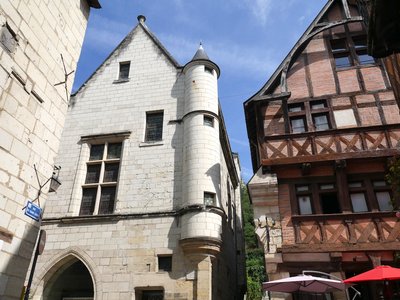
Musée Le Carroi et la Maison Rouge - Amis saint Colomban HistoricalRue Voltaire in Chinon
This medieval street tells part of the history of the city. The site of the old Verdun Gate of the city walls became famous because it was crossed by Joan of Arc during her visit to Charles VII. The Red House with its half-timbering is worth admiring, next to the museum "Le Carroi" offers temporary exhibitions.
A little further on, the church of Saint-Maurice, unfortunately closed. The only parish church in the Ville-Fort, the present Saint-Maurice church was rebuilt from the 12th century and then gradually enlarged until the 16th century. The central nave and the choir are covered with richly decorated "Angevin" type vaults with rounded ribbed vaults, while the later aisle is covered with vaults whose complex ribbing falls on Renaissance capitals.
Le Carroi Museum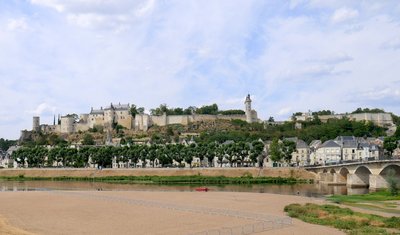
Vue de la Forteresse au-dessus de la ville de Chinon - Amis saint Colomban HistoricalThe royal fortress of Chinon
From the Place de la Brèche, in the city centre, you can reach the entrance of the Fortress with a lift.
The site of the Fortress has been occupied for three thousand years, as recent archaeological excavations have revealed. In Gallo-Roman times, Chinon was a small town. On the hillside, constructions made of stone or more modest, mud bricks, develop. Then, in the context of the end of the Roman Empire, the promontory is fortified and becomes a castrum evoked by the historian Grégoire de Tours. The promontory fortified in the 5th century continues to be occupied in the Merovingian and Carolingian periods. Vast buried silos and utilitarian buildings from this period have been found. Chinon is home to a royal monetary workshop in the 7th and 8th centuries.
In the 10th century, the Fortress was held by the Counts of Blois, great vassals of the King of France.
In the 11th century, the Counts of Anjou strongly threatened the power of the Counts of Blois. They seized Touraine in 1044. The Fortress of Chinon is at the centre of the continental possessions of the King of England Henry II Plantagenet, who in 1154 became master of an empire extending from Scotland to the Pyrenees.
Joan of Arc came to meet Charles VII at the Fortress of Chinon.
From the 16th century onwards, the Fortress of Chinon had no strategic role, it was abandoned in favour of more modern castles. In 1824, in spite of the dangerousness of the site, the park of the Fortress was converted into a public promenade.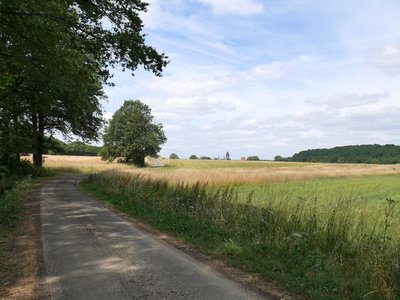
La Via Columbani en bordure du camp militaire et des cultures avant Fontevraud-L’Abbaye - Amis saint Colomban PanoramicFontevraud forest, military camp access forbidden
During this stage you go along the military camp of Fontevraud. It is important not to enter the training camp of the 2nd dragoon regiment specialising in nuclear, biological and chemical weapons, based at Fontevraud l'Abbaye.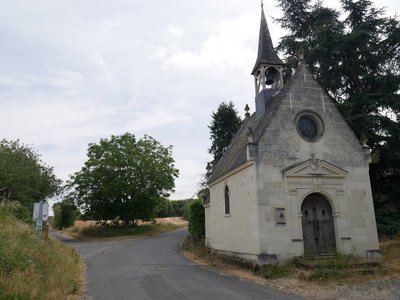
Chapelle Notre-Dame au bord de la Via Columbani avant Fontevraud - Amis saint Colomban TouristNotre-Dame de Pitié Chapel at Fontevraud-l'Abbaye
Sie entdecken diese Kapelle bei Ihrer Ankunft in Fontevraud-l'Abbaye.
Es wurde von den Offizieren der Äbtissin Eleonore de Bourbon errichtet, um der Jungfrau Maria dafür zu danken, dass sie sie 1579 vor der Pest gerettet hat.
Le cloître de l’abbaye Notre-Dame de Fontevraud - Amis saint Colomban HistoricalNotre-Dame de Fontevraud Abbey
Notre-Dame de Fontevraud Abbey was founded by Robert d'Arbrissel, a gyrovaga preacher from Brittany. In 1099, he settled in the forest of Bort, a large community was created with substantial financial and material means. The abbey developed and a village was established at the gates of the community in the 12th century.
The transformation of the abbey into the dynastic necropolis of the Plantagenets greatly contributed to its development. Henri II, Count of Anjou and Maine, Duke of Normandy and Aquitaine, King of England, married to Eleanor in 1152, made his first visit there on 21 May 1154. The couple entrusted the abbey with their two youngest children. In 1189 Henri II died in Chinon, his remains were deposited in the abbey church of Fontevraud. Richard the Lionheart will be buried next to his father in this same royal abbey church.
In the centuries that followed the abbey became prosperous and trade and industry developed. In the 17th century there were five mills, the surrounding fertile land favoured the cultivation of cereals. A market hall was built to promote trade. In the 18th century the abbey welcomed the four youngest daughters of King Louis XV. The Revolution led to the closure of the abbey and the ruin of the buildings. In 1804 the buildings were converted into a prison with more than 1000 prisoners. The presence of the prison staff favoured economic activity in the town of Fontevraud.
The closure of the Central House of Fontevraud in 1963 was followed by the destruction of most of the buildings erected during the 150 years of occupation of the site by the prison administration. The complex became the property of the Ministry of Cultural Affairs. The objective was then to recover the profile of the former Royal Abbey. Today the abbey complex has become a cultural centre.
More information: Wikipedia
L’église Saint-Michel de Fontevraud - Amis saint Colomban TouristSaint-Michel parish church at Fontevraud-l'Abbaye
Since its foundation, the religious community of Fontevraud has employed workers and craftsmen for the construction of the abbey. These men and women organised themselves around a village which would take the name of Fontevraud. In 1170, Abbess Audeburge asked King Henry II for financial aid to build a parish church near the monastic enclosure. Successive parish priests were appointed by the abbesses. The parish church will be under the name of Saint-Michel.
This Romanesque church was remodelled in the 15th century and a caquetry was built in the 18th century to shelter the poor and destitute.
In the choir of the church you can admire a carved wooden altar covered with gold leaf from the abbey church of Notre-Dame. It was commissioned in the 17th century by the abbess for the abbey church of Notre-Dame. The front of the altar represents the Last Supper and the tabernacle is surmounted by a triangular pediment where two angels reveal Christ and the disciples of Emmaus.
Information panel in the church.
Description
From the place Saint-Michel d'Azay-le-Rideau take left, rue Philippe de Commines, first street on the right, rue Rabelais, rue du Commerce at the small car park on the left, rue R. Carnot, cross the Vienne, first street on the right, quai Danton.
- After the swimming pool on the left, rue de la Porte du Bourg, first dirt road on the right, on the right at the junction with route de Sauvegrain, on the left, route de Pontillé, follow the Vienne river.
- La Chaussée to the right on the D 751, twice to the left to go up rue du Jard, to the right along the fields of crops, stay on your left, cross the tarmac road, Chemin de Fontevrault at la Chaussée
- Turn left at the crossroads, tarred road, chemin de Couziers to Saint-Germain, second road on the right, chemin de la Taille, follow on the edge of the forest, with a short passage through the forest, cross the fields.
- Right in front of the chapel, rue de l'Hermitage, right, rue du Logis Bourbon, you go along the monastic enclosure of the abbey and you arrive on the place Saint-Michel.
- Departure : Saint-Étienne Church, Place de l'Église Saint-Étienne, 37500 Chinon
- Arrival : Saint-Michel Church, place Saint-Michel, 49590 Fontevraud-l’Abbaye
- Towns crossed : Centre-Val de Loire and Pays de la Loire
Altimetric profile
Report a problem or an error
If you have found an error on this page or if you have noticed any problems during your hike, please report them to us here:





